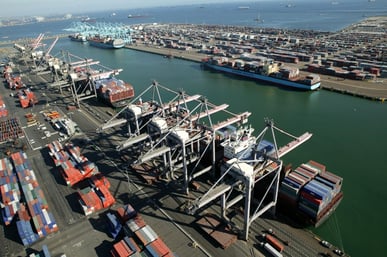September 30, 2020 -- Oslo, Norway -- Long-term ocean freight rates remain unbowed by the impact of the global coronavirus pandemic, with the latest XSI® Public Indices report from Xeneta showing a decline of just 0.1% across September. Spot rates, meanwhile, remain at an all time high. However, with carriers now moving to reinstate tonnage on key routes, question marks remain over the mid to long-term resilience of rates against a backdrop of on-going economic uncertainty.
Coronavirus may have derailed economic activity across the board, but, thanks to proactive strategies from the world’s container carriers (including cancelling sailings and adjusting routes), long-terms rates have defied expectations. According to XSI®, which is based on crowd-sourced data from leading shippers - utilising over 200 million data points, covering more than 160,000 port-to-port pairings – year-on-year rates have fallen by just 2.2%, down 2% since the start of 2020. September’s development follows on from a decline of 1.8% in August. However, Xeneta warns that while September reports a decline in its XSI, it already sees substantial increases for contracted rates for Q4 2020 - and even more so expected for Q1 2021.
Dynamic Market
“Suffice to say, there’s many in the industry that continue to be taken by surprise by the apparent resilience of the segment’s all-important long-term rates,” comments Xeneta CEO Patrik Berglund. “This has been good news for carriers and less positive for shippers looking to negotiate new contracts. On top of that we see spot rates ‘hitting it out of the park’, with Far East – US trades commanding higher price tags than ever before. There’s a shade of the surreal to developments when we look at the wider economic and geopolitical context.”
Berglund says that carriers are in a good position to post solid profits if they manage to keep it a “seller's market” over a prolonged period. Both US and EU shippers are set to begin RFQs on the contract market for significant volumes in the coming weeks. If carriers can sustain the current rates, then the upcoming tender season (from Q4 2020-Q1 2021) can initially be locked in at very high rate levels.
He notes: “Postponing tenders would be a very attractive alternative for shippers, but it will be hard to get carriers to agree to this. Buying on the spot market is a temporary possibility, which is full of risk and costly, but can be an attractive short-term alternative for shippers looking to get through the worst before returning to a more favourable contract market.”
Regional Rundown
According to September’s XSI®, European imports fell by 0.3% (down 1.7% year-on-year) with exports declining by 0.4% (up 0.4% on September 2019). It was a development mirrored on the Far East market where imports slipped 0.3% and the export benchmark lost 0.2% of its value. Regional imports are now down 1.9% year-on-year, while exports are 2.6% lower, but 0.3% up since the start of the year. The US import index provided a bright spot for carriers, up 0.5% (but down 1.8% against September 2019), while exports declined by 2.6% for the month, some 6.4% lower than the same point last year.
Berglund gives the following analysis: “The trans-Pacific Eastbound is on a historic high and it's the worst time-to-market for shippers looking to secure new long-term rate agreements in Q4 and Q1. If rates stay high, the impact will trickle into the main tender cycle for this period come Q1-Q2. We already see long term rates with +30% increases coming into the Xeneta platform - and expect more to come on this corridor the longer the spot market remains high. Shippers report constant fire-fighting mode as equipment is scarce and carriers push contract players onto the spot market, as it offers a much better yield.
“Asia-Europe front- and backhaul is also very strong with the fronthaul already clocking in contract rates at a 30% rate increase. We expect to see further increases as more and more European shippers settle their long-term rates this upcoming quarter.”
He continues: “On the trans-Atlantic westbound and the and the North Europe – South America East Coast we see different trends. Both corridors have been on a slow downward trend for both the spot and contract market since the beginning of the year. However, both these corridors currently remain at a healthy rate level for the carriers, and at the same time, acceptable rates for shippers.”
Increasing Complexity
Concluding, Berglund notes: ““We now see early indications of reaching a plateau for the short-term market across key benchmarks, with long-term rates increasing and covering some of the gap between the spot and contract market. Shippers need to be on the lookout for short-term rate reductions in order to understand where the long-term market is heading. The market, and indeed the wider world, remains in a state of flux, so there’s zero certainty on the horizon. What we do know is that tonnage has to return and that will impact upon the supply/demand dynamic. Individual carriers are also adjusting their own organizations with, for example, Maersk streamlining (phasing out its Damco and Safmarine brands), while Pacific International Lines (PIL) is slipping out of the first division (namely the top 10 carriers) after recent asset disposals.
“It’ll be interesting to see how this complex range of internal and external factors impacts upon the industry and rates going forwards. XSI® will help everyone navigate, understand and adjust to the latest developments.”
Companies participating in Oslo-based Xeneta’s crowd-sourced ocean and air freight rate benchmarking and market analytics platform include names such as ABB, Electrolux, Continental, Unilever, Lenovo, Nestle, L’Oréal, and Thyssenkrupp, amongst others.
To get the full XSI® Public Indices report, please visit: https://www.xeneta.com/xsi-public-indices


-1.jpg)

